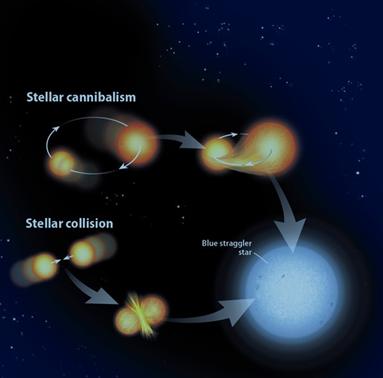Blue Straggler Stars
Context
Indian Institute of Astrophysics, Bengaluru, researchers have found support for one way to understand the aberrant behaviour of Blue Straggler stars.
For this, the researchers also made use of the observations by the UVIT instrument (UltraViolet Imaging Telescope) of ASTROSAT, India’s first science observatory in space.
About
About Blue stragglers Stars:
- Blue stragglers, a class of stars on open or globular clusters that stand out as they are bigger and bluer than the rest of the stars; have intrigued scientists who have for long probed their origin.
- Carrying out the first-ever comprehensive analysis of blue stragglers, Indian researchers found that half of the blue stragglers in their sample are formed through mass transfer from a close binary companion star, one third are likely formed through collisions of 2 stars, and the remaining are formed through interactions of more than 2 stars.
- A bunch of stars born at the same time from the same cloud form a star cluster.
- As time passes, each star evolves differently depending on its mass.
- The most massive and bright stars evolve and move off the main sequence creating a bend in their track, known as the turnoff.
- Stars above this bend or brighter and hotter stars are not expected in a cluster, as they leave the main sequence to become red giants.
- But in 1953, Allan Sandage found that some stars seem to be hotter than the turnoff of the parent cluster.
- Initially, these blue stars still straggling above the turnoff were not part of these clusters.
- However, later studies confirmed that these stars are indeed cluster members, and they were termed “
- ”.
- The only probable way these stars can still be present in these clusters is if they have somehow acquired extra mass along the way while on the main sequence.
- Confirming the mechanisms of the mass gain required a study using a large sample of blue-straggler stars and estimates of the mass they have gained.


|
Indian Institute of Astrophysics
|





